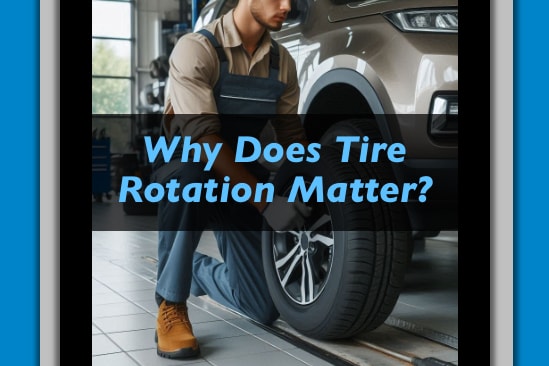
Possibly the most overlooked maintenance item on many vehicle-owner’s checklists, today we’re going beyond the, “because I said so,” to explain not just why it matters, but how different variables affect, and are affected by, the wear and tear of your car’s shoes.
The Dangers of Uneven Tire Wear
Consider for a moment that your tires are the only part of your car that makes direct contact with the road (hopefully). Thinking of your tires in this way alone can stress the importance of a quality contact patch with the road, and when throwing in environmental challenges like rain and general road debris, without good tread depth you’re running greater risk of losing that contact with the road itself. It’s easy to jump to the thought of bald tires as an extreme example, but somewhere in the middle are variants of wear patterns that approach the same issues.
In this vein, worn tires increase your risk of blowouts, as the thinner the tread layer, the thinner the outer protection and the closer the internal belts and inner liner is to everything we’re driving upon. And though this is an indication of deeper issues, a tire that’s worn enough to become out of balance can have the knock-on effect of uneven brake wear as well. Commonly, ignoring one small issue in your vehicle can become one large issue in the end.
With that thought experiment out of the way, let’s get onto…
Understanding Tire Wear: The Variables
We know our tires are vital for delivering the stop and go power of our vehicle to the road, but let’s not ignore the different stresses tires experience depending on not just our car, but us as well. Let’s look quickly at the differences based on drivetrain configuration:
Front vs. Rear Tires
- Front-Wheel Drive (FWD): No surprise, but with front-wheel drive, the front tires are doing most of the heavy lifting. When you accelerate, brake, or turn, the front wheels are responsible for everything, not to mention they’re already carrying the most weight, as they’re straddling your engine (unless you have a cool rear-engine setup of course).
- Rear-Wheel Drive (RWD): We’ll get to this in a sec’, but a large factor here is your personal driving habits. Provided you aren’t pretending you’re driving a dragster, you may be surprised that once more, the front tires will receive slightly more wear, simply due to the aforementioned weight of the motor, as well as their cornering duties.
- All-Wheel Drive (AWD): While the wear can be more evenly distributed, the complexity and additional weight of all-wheel drive vehicles can actually cause increased wear all around as compared to the above configurations.
Driving Habits/Road Conditions
Watch any rally racing highlights and contemplate how similar they are to the the way you travel around town. If that’s you, then you likely already have purchased a few tires already, but if not, the news here is that aggressive driving, heavy braking, and excessive cornering accelerate tire wear.
Though you probably knew that one, something we tend to overlook are the streets and highways we travel. The worse the road, the more abuse our tires receive. Again, not mind blowing, but also take into account that without tire rotations you’re not just accelerating your tire wear, you’re depending on said tires to navigate these hostile environments while still starting, stopping, and cornering in a safe manner.
Tire Compounds
One more thing to add to the list of variables, different tires are made for different jobs. At the risk of sounding like Bubba Buford, there are summer tires, winter tires, all-season tires, all-terrain tires, sport truck tires… you get the idea. Anyway, different tires are made up of different compounds, and to simplify, some are softer than others. Unless you specifically bought something special, you’re likely riding on some flavor of passenger/all-season tires. There, of course, is a range within this general segment that bump up against “performance” on one end and “long-lasting” on the other, and it is within this spectrum you’ll find an expected mileage for each. Factoring in everything we discussed above, your “results may vary”.
So, what does all of this mean? It means that we should all be paying attention to our recommended tire rotations, not just for our own safety, and that of our passengers, but also because it extends the life of our precious rubber hoops, thus keeping hundreds of dollars safely stashed in our piggy banks.
If you’d like our techs to swap those wheels around for you, then we invite you to check out our tire rotation service page and schedule your appointment today. Regardless, be sure to take a look at the mileage on your tires and make sure you get it taken care of, we want you safe out there. Take care, everyone, and we’ll see ya’ on the road!